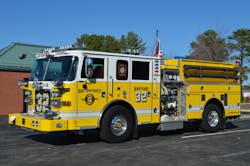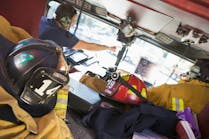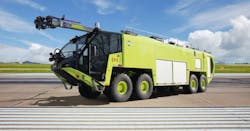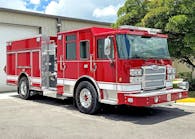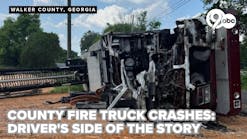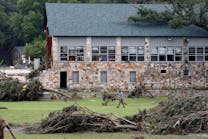There are thousands of parts and components that are utilized in the construction of a new piece of fire apparatus. When you consider the complexity of modern vehicles, it is no surprise that it requires an extensive background in mechanical and electrical engineering to fully understand how all of these components interact to provide a safe and reliable vehicle. For this reason, fire apparatus manufacturers employ a number of degreed engineers who are responsible for integrating all of these components, many of which are unique to a specific design required by the fire department’s specifications. In many cases, the success of a modern, well designed and manufactured fire apparatus is due in large part to the engineering group.
The first apparatus committee meetings generally set the stage for the success of the specification process. The ideal size for most committees is four to five personnel, with representation from experienced officers, engineers or technicians, and maintenance disciplines. While other outside opinions can provide valuable input, varied suggestions on vehicle design and what is needed on the apparatus tends to not only increase vehicle complexity, but overall cost as well. While no scientific studies have been undertaken on this, our observations seem to show that larger, expanded committees result in a cost increase of approximately 15 percent. The old proverb “Too many cooks spoil the broth” may be appropriate when it comes to sizing apparatus committees.
Review the details
There are several critical steps in the specification process, including interviews with prospective bidders, specification development, bid review and financial analysis and final vehicle inspection. One part of the process that is often overlooked is the preconstruction engineering conference. This meeting is where all details of the vehicle are reviewed, and it provides the opportunity to determine final design configurations for areas such as dashboard, cab seating, pump panel and interior body compartments.
The members attending the preconstruction conference should again be limited to four to five committee members who worked through the entire process and are in a position to make decisions on the final configuration of the vehicle. While most manufacturers do not require a final decision on cost-related changes, it is a good idea to have one person in the group who is authorized to approve monetary changes.
One of the most important concepts to follow is that the preconstruction conference should be conducted at the manufacturer’s plant, where the department will have the ability to tour the facility and have access to the various engineering disciplines that will be responsible for the production of your new apparatus. While it may be more convenient to hold the preconstruction conference at your fire station in the evening or over the weekend, the ability to have immediate access to vehicles in production, the engineering staff and other factory support generally outweigh the convenience of locally hosted sessions. If this is the first apparatus that the department has placed on order from the apparatus manufacturer, you should allow a minimum of two days on site to provide sufficient time to review all aspects of the specifications and conduct a tour of the facility.
While some in the department may view the preconstruction trip as a destination vacation, nothing could be further from the truth. From personal experience assisting at hundreds of these engineering conferences, an 8- to 10-hour day is not uncommon, and the process requires at least one person to document the various discussions. Notations should be made within both the specifications and blueprints to indicate changes and modifications identified during the meetings. Remember, if it is not written down, it will probably not happen.
During the preconstruction meeting, there should be technical documentation that was required as a part of the department’s boilerplate, including a weight analysis, electrical load analysis, engine performance scan and vehicle turning radius charts. In preparation for the meeting, the committee should have a detailed equipment inventory, including weights for each piece of equipment that is going to be carried on the new apparatus. It is the fire department’s responsibility to advise the manufacturer as to the hose, tools and equipment that are planned for the vehicle.
Section 12.1.2 of NFPA 1901 states that the purchaser shall provide a listing of equipment with weights, or the equipment allowance will defer to Table 12.1.2, which lists the minimum equipment allowance for various types of apparatus. Unfortunately, overweight apparatus is common and results in poor handling, braking performance and, in extreme instances, the vehicle must be removed from service until corrective action can be taken. During the preconstruction meeting, front- and rear-axle loadings, based upon the planned equipment locations, need to be reviewed and validated by all parties. This is particularly critical for combination units, such as rescue-engines and single-axle quints, where weight balance and axle loadings need to be confirmed based upon the developed specifications and the departments equipment cache.
For example, on a pumper outfitted with a compartment body that has more than 250 cubic feet of compartment space, the minimum equipment payload allowance is 2,500 pounds. This body configuration is generally designed with full height and depth compartment on each side of the body with a center, rear compartment. Adding topside locker or coffin compartments along with dunnage area above the fire pump provides space for additional equipment storage. If you are unsure as to how much equipment your apparatus is carrying, one method is to take the vehicle to a location with certified scales, and after making sure that the water and foam tanks are filled, have the entire apparatus weighed. Then return to the station and remove all of the portable equipment that is carried inside of the compartments, including the cab and front bumper, and then re-weigh the vehicle.
Supplying accurate equipment inventory information with the departments bid specifications and confirming this with the manufacturer’s engineering group during the preconstruction conference is critical to ensuring that the apparatus will not become overloaded during the vehicles expected life cycle.
The layout of adjustable shelves, trays, tool boards and other compartment accessories will require each of these to be assigned to a specific compartment during the meeting. If the department desires to duplicate an existing layout or has observed a specific arrangement that they favor, then digital images along with dimensions of the compartment and equipment-mounting locations, will assist the sales and engineering personnel.
An engine scan is a multi-page document that provides data on engine-transmission performance for acceleration, gradeability and speeds at specific points. With recent changes to diesel engine emissions, the expected performance of the newer engines may be considerably different from models produced several years earlier. If an engine scan was not a requirement within the department’s original specifications, request that this material be available for review and discussion during the preconstruction meeting. Vehicle top speed, along with the rear-axle ratio and transmission model, will impact the performance of the apparatus.
During the preconstruction meeting the committee members should go through each page of the specifications to ensure that all aspects of the apparatus are in line with the original intent of the committee. Any modification to the specifications, regardless of whether it impacts the final cost, should be documented in a change order for approval by the department.
In sum
Well designed and laid out fire apparatus just don’t happen by chance. Departments that express satisfaction with their new vehicles put in a lot of hard work developing the specifications and working with the manufacturer’s sales and engineering personnel to review and detail all aspects of the apparatus. Once the unit is built, it’s too late to change things without considerable cost, so spend your time up front and it will pay big dividends.
